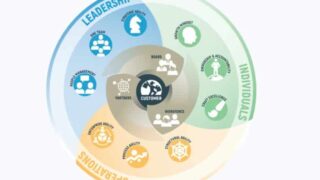Most of us know that agile began in software development, but companies are just beginning to realize the need for Business Agility. Marketers need to be able to collaborate not just within their own area, but with other key business areas such as sales, customer service and product development.
“Business Agility is a set of organizational capabilities, behaviors, and ways of working that affords your business the freedom, flexibility, and resilience to achieve its purpose. No matter what the future brings,” according to the Business Agility Institute.
With this new wave of agility, the customer is central to the way we work. Therefore it’s important for marketers to understand the full picture of what’s happening with customers along every step of the way.

Let’s discuss ways that you can improve collaboration with other departments that have a lot of customer interaction.
Table of Contents
Aligning with sales
Your sales teams typically have the most interaction with buyers, so forming a close-knit partnership is critical to having your marketing messages be authentic and really honing in on customer pain points. Agile marketing is less about developing heavy, formal processes for doing this, but more about making sure interactions can occur easily and often.
Do you remember playing Red Rover as a child? The game says, “Red Rover Red Rover send Stacey right over,” and I would go and join your team. So, a fun way to collaborate is Red Rover style! Invite someone from the Sales team to attend a stand-up meeting on a regular cadence, such as weekly, and give a brief update (5 minutes or less) on what they’re hearing from customers.
In reverse, send someone over from Marketing to a weekly meeting that their team has and share some of the feedback you’ve gotten from recent campaigns. This informal shared collaboration doesn’t have to take a lot of time, but those five-to-ten minutes a week can add up to a lot of value if both of you learn something new about your customers.
Collaborating with product development
Chances are high that you’re going to be marketing something that they’re developing, so why wait until it’s done to get the inside scoop? The marketing team can learn a lot by hearing what’s being built and when it’s going to be released. Once again, formal meetings aren’t the idea here, but frequently stepping outside of one’s corporate lane to hear what’s happening in another area is key for really collaborating as a customer-centric business.
Using the same Red Rover team swap approach here, have a marketer attend a Sprint Review if the team has them where you can get an earlier look at the product. Learn who the intended user is and when it’s going to market. It doesn’t have to be a manager or director attending — in fact, rotating marketing team members is a great way for everyone to get a glimpse into the future. Just make sure whoever you send over shares what they learned with the rest of the team.
Getting feedback from customer service
Your customer service team hears the good, the bad and the ugly from the people you’re marketing to, so be sure to loop them into your feedback cycle.
I worked on a marketing team for a fast food chain where customer service was actually part of our responsibility. We’d share stories of what we were hearing from the letters we received from customers (this predates email) and this would help inform us of stories to write for our publications. So even without any fancy CRM tools, we can integrate our two worlds by sharing stories.
The “Three Amigos”
On agile teams in software development, there’s the concept of the “Three Amigos” where a software developer, tester and business analyst work together to fully understand how they’re going to solve the problem when work begins, replacing the need to hand-off work from one role to the next. Within marketing, this same concept can work well to understand our customers’ problems. The Three Amigos can be someone from Marketing, Sales, Customer Service and potentially Product Development (which makes four).
In Scrum, one of the agile frameworks, some teams hold a Scrum of Scrums meeting where multiple teams connect and quickly update each other on what’s happening in their team in 15 minutes or less. A Scrum of Scrums with your three or four amigos is a great collaborative way to build in cross-team communication.
Business agility is all about everyone in the company best serving the customer, so finding easy, lightweight approaches to building in cross-team collaboration will result in a better overall customer experience.
The post How agile marketers can work with other teams to improve customer experience appeared first on MarTech.



